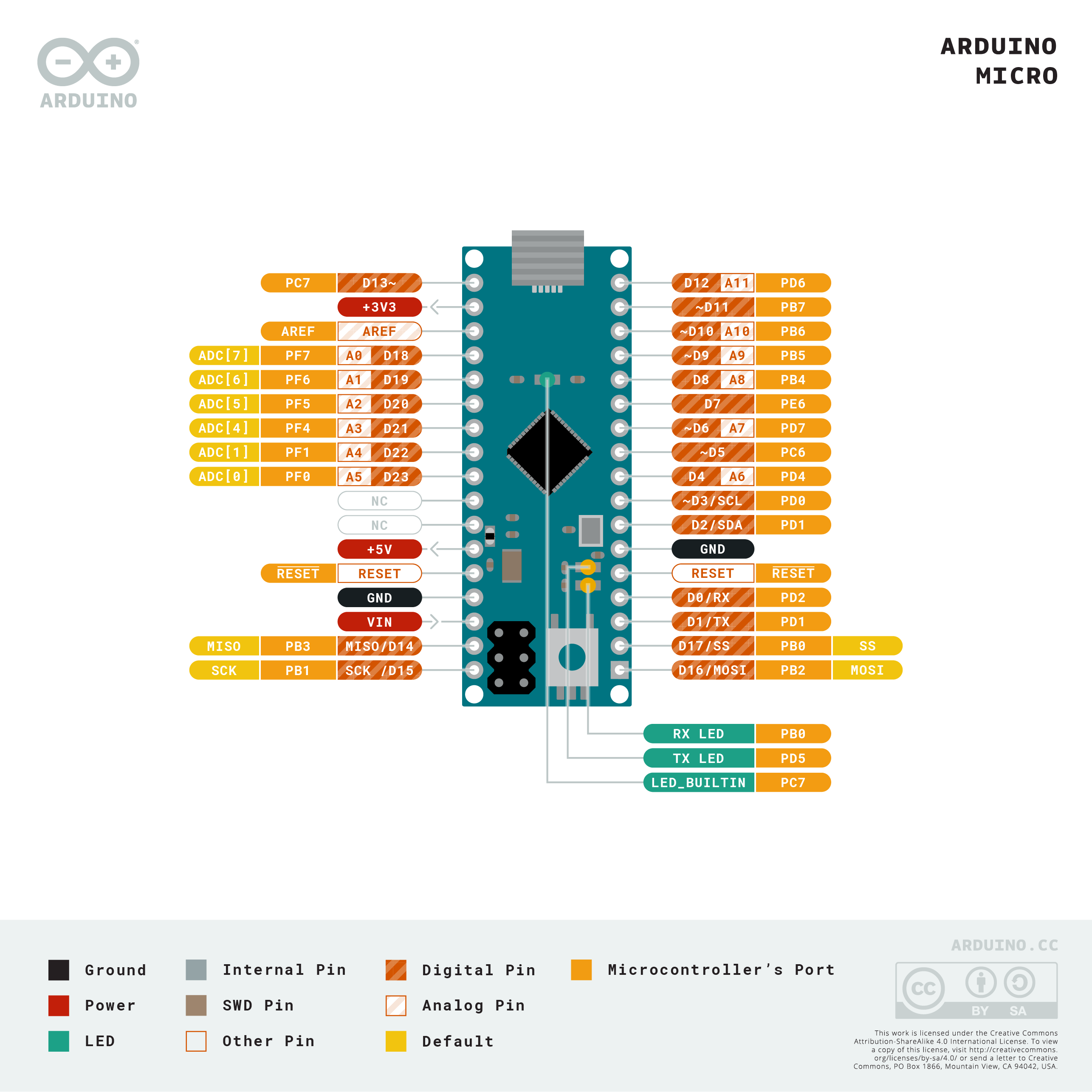

- #Arduino micro pinout serial
- #Arduino micro pinout portable
- #Arduino micro pinout software
- #Arduino micro pinout Pc
- #Arduino micro pinout series
#Arduino micro pinout series
All four buffers have 3.3K resistors in series for protection.īut there is another problem as the ENABLE pin 13 (CIPO) of the buffer of 74VC125 is always tied to GND. Therefore one of the buffers is connected in reverse order (see the IC1D part in the above schematic). Three of the pins, COPI, SCK and CS carry signals from the Arduino to the card and the CIPO carries signals from the card to Arduino. We have to provide 3.3 – 3.6V as the supply voltage to the buffer in order for this to work. It can translate the 3.3V logic signals from the card to and from a 5V Arduino Uno. The 741VC125 on the module is a quadruple 3-state buffer. This is because any voltages exceeding 3.6V can damage the SD card permanently. But if your microcontroller operates at voltages exceeding 3.3V, then you need a logic level shifter such as the module we’re discussing. Instead, you can directly interface the card to the microcontroller from the card slot. If your host board uses 3.3V as the logic supply (such as Arduino Due), then you do not need this module at all. We will use the SPI mode and its pin assignments.Ī micro SD card has an operating voltage of 3.3V.
#Arduino micro pinout serial
The Serial Peripheral Interface (SPI) mode is slow but requires less overhead compared to SD mode, and is compatible with any microcontroller with built-in SPI. The SD mode is the fastest and is used in smartphones, digital cameras, etc. The pin assignments for these modes are different. There are two ways a micro SD can be interfaced with a microcontroller – SPI mode and SD mode. There are 8 pins on the micro SD card which you should avoid touching as you may damage the card with static electricity, even though it is protected against ESD. Now a window will open on which you have to select FAT or FAT16 from the drop-down list for the file system and then click "Start Format". If you are on Windows 7, right-click the card volume icon and select the "Format" option.
#Arduino micro pinout Pc
You need a card reader and a PC to format the card. The library supports FAT16 and FAT32 file systems, though it is recommended to format to FAT16 when possible. The SdFat library requires a properly formatted card to work. It has many registers associated with it. The card interface controller is the section that processes user commands and reads from or writes to the actual memory core. This sets the pins to appropriate modes and selects and monitors the operating voltages and other parameters required for physical interfacing.

The interface driver connects to the external interface pins. Internally the card is organized as interface driver, card interface controller, and memory core. Micro SD measures 11mm x 15mm and is 1mm thick. The microSD card is a type of removable NAND-type small Flash memory card format which was introduced in 2003. Before we delve into interfacing, let’s have a basic understanding of what an SD card is, how it is organized, different forms and pinouts of it. What we’re going to do here is to interface a microSD card with an Arduino Uno using the SdFdat library developed by William Greiman and it is based on the Simplified SD Card Specification. A simplified version (it isn’t that simple) of the SD card specification is available for the public on the SD Card Association’s website.
#Arduino micro pinout software
Most of the documents are confidential and are only available to manufacturers and software companies. They standardize and publish the necessary specifications to manufacture and implement SD cards. The Secure Digital (SD) standard is maintained by the SD Card Association. You could understand it just by reading the SD card spec sheet. SD cards and USB flash drives have become indispensable things in our everyday life.Įven though you could insert an SD card in your phone or computer easily and browse all your files, hardware interfacing an SD card of any type with Arduino or similar development boards is not that easy.
#Arduino micro pinout portable
Portable version flash memory is available as SD cards, in many capacities and form-factors. The EEPROM memory of all available microcontrollers is limited in size. There will be times when you have to store a large amount of log data and other information for your Arduino project, for example, a GPS logger.


 0 kommentar(er)
0 kommentar(er)
